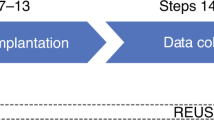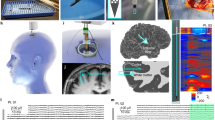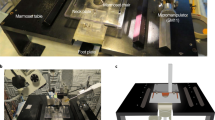Abstract
Multi-electrode arrays such as Neuropixels probes enable electrophysiological recordings from large populations of single neurons with high temporal resolution. By using such probes, the activity from functionally interacting, yet distinct, brain regions can be measured simultaneously by inserting multiple probes into the same subject. However, the use of multiple probes in small animals such as mice requires the removal of a sizable fraction of the skull, while also minimizing tissue damage and keeping the brain stable during the recordings. Here, we describe a step-by-step process designed to facilitate reliable recordings from up to six Neuropixels probes simultaneously in awake, head-fixed mice. The procedure involves four stages: the implantation of a headframe and a removable glass coverslip, the precise positioning of the Neuropixels probes at targeted points on the brain surface, the placement of a perforated plastic imaging window and the insertion of the probes into the brain of an awake mouse. The approach provides access to multiple brain regions and has been successfully applied across hundreds of mice. The procedure has been optimized for dense recordings from the mouse visual system, but it can be adapted for alternative recording configurations to target multiple probes in other brain areas. The protocol is suitable for users with experience in stereotaxic surgery in mice.
This is a preview of subscription content, access via your institution
Access options
Access Nature and 54 other Nature Portfolio journals
Get Nature+, our best-value online-access subscription
$29.99 / 30 days
cancel any time
Subscribe to this journal
Receive 12 print issues and online access
$259.00 per year
only $21.58 per issue
Buy this article
- Purchase on Springer Link
- Instant access to full article PDF
Prices may be subject to local taxes which are calculated during checkout












Similar content being viewed by others
Data availability
The data used to generate Fig. 12 are publicly available as part of the Allen Brain Observatory Visual Coding–Neuropixels dataset. The data can be accessed via the AllenSDK (https://allensdk.readthedocs.io/en/latest/visual_coding_neuropixels.html), the DANDI Archive (https://dandiarchive.org/dandiset/000021) or the AWS Data Exchange (https://aws.amazon.com/marketplace/pp/prodview-r3vtavkhdgjli).
References
Jun, J. J. et al. Fully integrated silicon probes for high-density recording of neural activity. Nature 551, 232–236 (2017).
Steinmetz, N. A., Koch, C., Harris, K. D. & Carandini, M. Challenges and opportunities for large-scale electrophysiology with Neuropixels probes. Curr. Opin. Neurobiol. 50, 92–100 (2018).
Steinmetz, N. A., Zatka-Haas, P., Carandini, M. & Harris, K. D. Distributed coding of choice, action and engagement across the mouse brain. Nature 576, 266–273 (2019).
Zavitz, E. & Price, N. S. C. Understanding sensory information processing through simultaneous multi-area population recordings. Front. Neural Circuits 12, 115 (2019).
Kohn, A. et al. Principles of corticocortical communication: proposed schemes and design considerations. Trends Neurosci. 43, 725–737 (2020).
Kang, B. & Druckmann, S. Approaches to inferring multi-regional interactions from simultaneous population recordings. Curr. Opin. Neurobiol. 65, 108–119 (2020).
Siegle, J. H. et al. Survey of spiking in the mouse visual system reveals functional hierarchy. Nature 592, 86–92 (2021).
Jia, X. et al. Multi-regional module-based signal transmission in mouse visual cortex. Neuron 110, 1585–1598.e9 (2022).
Wang, Q. & Burkhalter, A. Area map of mouse visual cortex. J. Comp. Neurol. 502, 339–357 (2007).
van Daal, R. J. J. et al. Implantation of Neuropixels probes for chronic recording of neuronal activity in freely behaving mice and rats. Nat. Protoc. 16, 3322–3347 (2021).
Siegle, J. H. et al. Reconciling functional differences in populations of neurons recorded with two-photon imaging and electrophysiology. eLife 10, e69068 (2020).
Groblewski, P. A. et al. A standardized head-fixation system for performing large-scale, in vivo physiological recordings in mice. J. Neurosci. Methods 346, 108922 (2020).
Holtmaat, A. et al. Long-term, high-resolution imaging in the mouse neocortex through a chronic cranial window. Nat. Protoc. 4, 1128–1144 (2009).
Goldey, G. J. et al. Removable cranial windows for long-term imaging in awake mice. Nat. Protoc. 9, 2515–2538 (2014).
Smith, G. B. & Fitzpatrick, D. Viral injection and cranial window implantation for in vivo two-photon imaging. Methods Mol. Biol. 1474, 171–185 (2016).
Heo, C. et al. A soft, transparent, freely accessible cranial window for chronic imaging and electrophysiology. Sci. Rep. 6, 27818 (2016).
Garrett, M. E., Nauhaus, I., Marshel, J. H. & Callaway, E. M. Topography and areal organization of mouse visual cortex. J. Neurosci. 34, 12587–12600 (2014).
Juavinett, A. L., Nauhaus, I., Garrett, M. E., Zhuang, J. & Callaway, E. M. Automated identification of mouse visual areas with intrinsic signal imaging. Nat. Protoc. 12, 32–43 (2017).
Chatterjee, S. et al. Nontoxic, double-deletion-mutant rabies viral vectors for retrograde targeting of projection neurons. Nat. Neurosci. 21, 638–646 (2018).
Steinmetz, N. A. et al. Neuropixels 2.0: a miniaturized high-density probe for stable, long-term brain recordings. Science 372, eabf4588 (2021).
Yang, L., Lee, K., Villagracia, J. & Masmanidis, S. C. Open source silicon microprobes for high throughput neural recording. J. Neural Eng. 17, 016036 (2020).
Scholvin, J. et al. Close-packed silicon microelectrodes for scalable spatially oversampled neural recording. IEEE Trans. Biomed. Eng. 63, 120–130 (2016).
Kim, K. et al. Artifact-free and high-temporal-resolution in vivo opto-electrophysiology with microLED optoelectrodes. Nat. Commun. 11, 2063 (2020).
Ghanbari, L. et al. Cortex-wide neural interfacing via transparent polymer skulls. Nat. Commun. 10, 1500 (2019).
Whitesell, J. D. et al. Regional, layer, and cell-type-specific connectivity of the mouse default mode network. Neuron 109, 545–559.e8 (2021).
Nunez-Elizalde, A. O. et al. Neural correlates of blood flow measured by ultrasound. Neuron 110, 1631–1640.e4 (2022).
Juavinett, A. L., Bekheet, G. & Churchland, A. K. Chronically implanted Neuropixels probes enable high-yield recordings in freely moving mice. eLife 8, e47188 (2019).
Hirayama, M. et al. Functional lacrimal gland regeneration by transplantation of a bioengineered organ germ. Nat. Commun. 4, 2497 (2013).
Stringer, C. et al. Spontaneous behaviors drive multidimensional, brainwide activity. Science 364, eaav7893 (2019).
Allen, W. E. et al. Thirst regulates motivated behavior through modulation of brainwide neural population dynamics. Science 364, 253 (2019).
Durand, S. NMDA receptor regulation prevents regression of visual cortical function in absence of Mecp2. Neuron 76, 1078–1090 (2012).
Durand, S. et al. A comparison of visual response properties in the lateral geniculate nucleus and primary visual cortex of awake and anesthetized mice. J. Neurosci. 36, 12144–12156 (2016).
Denman, D. J., Siegle, J. H., Koch, C., Reid, R. C. & Blanche, T. J. Spatial organization of chromatic pathways in the mouse dorsal lateral geniculate nucleus. J. Neurosci. 37, 1102–1116 (2017).
Niell, C. M. & Stryker, M. P. Highly selective receptive fields in mouse visual cortex. J. Neurosci. 28, 7520–7536 (2008).
Niell, C. M. & Stryker, M. P. Modulation of visual responses by behavioral state in mouse visual cortex. Neuron 65, 472–479 (2010).
Dorand, R. D., Barkauskas, D. S., Evans, T. A., Petrosiute, A. & Huang, A. Y. Comparison of intravital thinned skull and cranial window approaches to study CNS immunobiology in the mouse cortex. IntraVital 3, e29728 (2014).
Park, H., You, N., Lee, J. & Suh, M. Longitudinal study of hemodynamics and dendritic membrane potential changes in the mouse cortex following a soft cranial window installation. Neurophotonics 6, 015006 (2019).
Holtmaat, A. et al. Imaging neocortical neurons through a chronic cranial window. Cold Spring Harb. Protoc. 2012, 694–701 (2012).
Silasi, G., Xiao, D., Vanni, M. P., Chen, A. C. N. & Murphy, T. H. Intact skull chronic windows for mesoscopic wide-field imaging in awake mice. J. Neurosci. Methods 267, 141–149 (2016).
Kyweriga, M., Sun, J., Wang, S., Kline, R. & Mohajerani, M. H. A large lateral craniotomy procedure for mesoscale wide-field optical imaging of brain activity. J. Vis. Exp. 2017, 52642 (2017).
Obaid, A. et al. Ultra-sensitive measurement of brain penetration mechanics and blood vessel rupture with microscale probes. Preprint at https://www.biorxiv.org/content/10.1101/2020.09.21.306498v1 (2020).
Peters, A. Neuropixels Trajectory Explorer https://github.com/petersaj/neuropixels_trajectory_explorer (2022).
Brunner, C. et al. Whole-brain functional ultrasound imaging in awake head-fixed mice. Nat. Protoc. 16, 3547–3571 (2021).
Kitamura, K., Judkewitz, B., Kano, M., Denk, W. & Häusser, M. Targeted patch-clamp recordings and single-cell electroporation of unlabeled neurons in vivo. Nat. Methods 5, 61–67 (2008).
Roome, C. J. & Kuhn, B. Chronic cranial window with access port for repeated cellular manipulations, drug application, and electrophysiology. Front. Cell. Neurosci. 8, 379 (2014).
Campbell, M. G. et al. Distance-tuned neurons drive specialized path integration calculations in medial entorhinal cortex. Cell Reports 36, 109669 (2021).
Ke, M.-T., Fujimoto, S. & Imai, T. SeeDB: a simple and morphology-preserving optical clearing agent for neuronal circuit reconstruction. Nat. Neurosci. 16, 1154–1161 (2013).
Azaripour, A. et al. A survey of clearing techniques for 3D imaging of tissues with special reference to connective tissue. Prog. Histochem. Cytochem. 51, 9–23 (2016).
Wong, M. D., Dazai, J., Walls, J. R., Gale, N. W. & Henkelman, R. M. Design and implementation of a custom built optical projection tomography system. PLoS One 8, e73491 (2013).
Sharpe, J. Optical projection tomography. Annu. Rev. Biomed. Eng. 6, 209–228 (2004).
Nguyen, D. et al. Optical projection tomography for rapid whole mouse brain imaging. Biomed. Opt. Express 8, 5637–5650 (2017).
Mayer, J. et al. OPTiSPIM: integrating optical projection tomography in light sheet microscopy extends specimen characterization to nonfluorescent contrasts. Opt. Lett. 39, 1053–1056 (2014).
Galland, R. et al. 3D high- and super-resolution imaging using single-objective SPIM. Nat. Methods 12, 641–644 (2015).
Hillman, E. M. C., Voleti, V., Li, W. & Yu, H. Light-sheet microscopy in neuroscience. Annu. Rev. Neurosci. 42, 295–313 (2019).
Shamash, P., Carandini, M., Harris, K. D. & Steinmetz, N. A. A tool for analyzing electrode tracks from slice histology. Preprint at https://www.biorxiv.org/content/10.1101/447995v1 (2018).
Liu, L. D. et al. Accurate localization of linear probe electrode arrays across multiple brains. eNeuro 8, ENEURO.0241-21.2021 (2021).
Tyson, A. L. et al. Accurate determination of marker location within whole-brain microscopy images. Sci. Rep. 12, 867 (2022).
Buccino, A. P. et al. SpikeInterface, a unified framework for spike sorting. eLife 9, e61834 (2020).
CatGT https://billkarsh.github.io/SpikeGLX/#catgt (2022).
ecephys_spike_sorting https://github.com/alleninstitute/ecephys_spike_sorting (2019).
IBL Python Libraries https://github.com/int-brain-lab/ibllib (2021).
O’Shea, D. neuropixel-utils https://github.com/djoshea/neuropixel-utils (2021).
Denker, M. et al. Elephant 0.11.1. DOI:10.5281/zendo.6470226 (2022).
The Allen SDK https://github.com/AllenInstitute/AllenSDK (2021).
Petersen, P. C., Siegle, J. H., Steinmetz, N. A., Mahallati, S. & Buzsáki, G. CellExplorer: a framework for visualizing and characterizing single neurons. Neuron 109, 3594–3608.e2 (2021).
GitHub. NeurodataWithoutBorders/nwb-jupyter-widgets: explore the hierarchical structure of NWB 2.0 files and visualize data with Jupyter widgets. https://github.com/NeurodataWithoutBorders/nwb-jupyter-widgets (2021).
Coordinates Jupiter Notebook https://github.com/AllenInstitute/neuropixels_protocol_resources (2021).
Madisen, L. et al. A toolbox of Cre-dependent optogenetic transgenic mice for light-induced activation and silencing. Nat. Neurosci. 15, 793–802 (2012).
Siegle, J. H. et al. Open Ephys: an open-source, plugin-based platform for multichannel electrophysiology. J. Neural Eng. 14, 045003 (2017).
SpikeGLX https://billkarsh.github.io/SpikeGLX (2022).
Fiáth, R. et al. Slow insertion of silicon probes improves the quality of acute neuronal recordings. Sci. Rep. 9, 111 (2019).
Cortex Lab. Sharpening Protocol https://github.com/cortex-lab/neuropixels/wiki/Probe-Sharpening (2022).
The International Brain Laboratory et al. Standardized and reproducible measurement of decision-making in mice. eLife 10, e63711 (2021).
Slezak, M. et al. Distinct mechanisms for visual and motor-related astrocyte responses in mouse visual cortex. Curr. Biol. 29, 3120–3127.e5 (2019).
Dombeck, D. A., Harvey, C. D., Tian, L., Looger, L. L. & Tank, D. W. Functional imaging of hippocampal place cells at cellular resolution during virtual navigation. Nat. Neurosci. 13, 1433–1440 (2010).
Acknowledgements
We thank the Allen Institute founder, Paul G. Allen, for his vision, encouragement and support. Primary funding for this project was provided by the Allen Institute. We thank the Transgenic Colony Management and Laboratory Animal Services for caring for the mice in this study. We thank the Neurosurgery and Behavior team for performing surgeries and training. We thank the Imaging team for performing OPT imaging.
Author information
Authors and Affiliations
Contributions
J.H.S. designed the experiments and the rigs. S.R.O. supervised the project. J.H.S. analyzed the data. S.D., J.H.S, S.R.O., T.K.R. and G.R.H. participated in the writing of the paper. S.D., T.K.R. and G.R.H. performed experiments. S.D., T.K.R. and G.R.H. tested and validated all components of the paper. A.C. and D.T.S. designed custom rig components under the supervision of C.F. J.A.L. co-developed the surgical procedure and trained new surgeons. A.W. and P.A.G. supervised habituation/training and surgery. C.B. developed analysis methods and edited the paper.
Corresponding author
Ethics declarations
Competing interests
The authors declare no competing interests.
Peer review
Peer review information
Nature Protocols thanks Celian Bimbard, Richard Fiath and the other, anonymous, reviewer(s) for their contribution to the peer review of this work.
Additional information
Publisher’s note Springer Nature remains neutral with regard to jurisdictional claims in published maps and institutional affiliations.
Related links
Key references using this protocol
Siegle, J. H. et al. Nature 592, 86–92 (2021): https://doi.org/10.1038/s41586-020-03171-x
Jia, X. et al. Neuron 110, 1585–1598.e9 (2022): https://doi.org/10.1016/j.neuron.2022.01.027
Siegle, J. H. et al. eLife 10, e69068 (2021): https://doi.org/10.7554/eLife.69068
Extended data
Supplementary information
Supplementary Information
Supplementary Tables 1 and 2
Source data
Source Data Fig. 12
Statistical source data.
Rights and permissions
Springer Nature or its licensor (e.g. a society or other partner) holds exclusive rights to this article under a publishing agreement with the author(s) or other rightsholder(s); author self-archiving of the accepted manuscript version of this article is solely governed by the terms of such publishing agreement and applicable law.
About this article
Cite this article
Durand, S., Heller, G.R., Ramirez, T.K. et al. Acute head-fixed recordings in awake mice with multiple Neuropixels probes. Nat Protoc 18, 424–457 (2023). https://doi.org/10.1038/s41596-022-00768-6
Received:
Accepted:
Published:
Issue Date:
DOI: https://doi.org/10.1038/s41596-022-00768-6
This article is cited by
-
Modified Neuropixels probes for recording human neurophysiology in the operating room
Nature Protocols (2023)
Comments
By submitting a comment you agree to abide by our Terms and Community Guidelines. If you find something abusive or that does not comply with our terms or guidelines please flag it as inappropriate.



